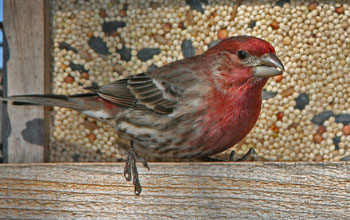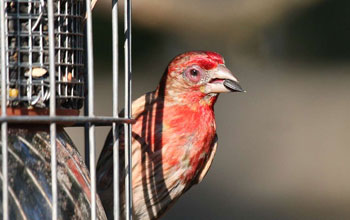
A healthy male house finch visits a seed feeder; the finches are common at bird feeders.
Credit: Carl Peters/Cornell University
Download the high-resolution JPG version of the image. (1.2 MB)

Male house finches are rose-red and brown; females are gray-brown and streaked.
Credit: Elena Petrcich/Cornell University
Download the high-resolution JPG version of the image. (2.5 MB)

House finches that contract eye disease (male shown here) develop swollen, weepy eyes.
Credit: Andy Davis/Cornell University
Download the high-resolution JPG version of the image. (112 KB)

Two male house finches on snow-dusted perches in Montana; these birds are healthy.
Credit: Jeanette Tasey/Cornell University
Download the high-resolution JPG version of the image. (1.2 MB)

A healthy male house finch perches on a bramble in Pennsylvania.
Credit: Kelly Colgan Azar
Download the high-resolution JPG version of the image. (581 KB)

House finch photo showing the beak, which is evolved for eating seeds.
Credit: Wikimedia Commons
Download the high-resolution JPG version of the image. (493 KB)
A disease in songbirds has rapidly evolved to become more harmful to its host at least twice in two decades, scientists report.
The
research offers a model to help understand how diseases that threaten
humans may change in virulence as they become more prevalent in a host
population.
"Everybody who's had the flu has probably wondered at
some point: 'Why do I feel so bad?'" said Dana Hawley of Virginia
Polytechnic Institute, lead author of a paper on the results published
today in the journal PLOS Biology.
"That's what we're
studying: Why do pathogens cause harm to the hosts they depend upon?
And, why are some life-threatening, while others only give you the
sniffles?"
Disease virulence is something of a paradox.
"The
jumping of a pathogen to a new host, such as bird flu jumping to
humans, is just the first step of disease emergence," said Sam Scheiner,
National Science Foundation (NSF) program director for the joint
NSF‒National Institutes of Health Ecology and Evolution of Infectious
Diseases Program, which funded the research.
"The subsequent
evolution of that pathogen in its new host can be critical to
determining further [pathogen] spread," Scheiner said.
"This study
is the first to confirm predictions that pathogens may evolve to become
more deadly. The results are important for planning responses to events
such as the bird flu outbreak in China."
To spread, viruses and
bacteria must reproduce in great numbers. But as their numbers increase
inside a host's body, the host gets more and more ill.
So a highly
virulent disease runs the risk of killing or debilitating its hosts
before the hosts can transmit the bug along. But sometimes pathogens
find the right balance through evolution. The new study shows that can
happen in just a few years.
Hawley and co-authors studied house finch eye disease, a form of conjunctivitis, or pinkeye, caused by the bacteria Mycoplasma gallisepticum.
It
first appeared around Washington, D.C., in the 1990s. The house finch
is native to the Southwest but has spread to towns and backyards across
North America.
The bacteria are not harmful to humans, which makes
them a good model for studying the evolution of dangerous diseases such
as SARS, Ebola and avian flu.
"There's an expectation that a very
virulent disease will become milder over time, to improve its ability
to spread," said André Dhondt, director of bird population studies at
Cornell University. "Otherwise, it just kills the host and that's the
end of it for the organism.
"House finch eye disease gave us an
opportunity to test this--and we were surprised to see it actually
become worse rather than milder."
The researchers used frozen
bacterial samples taken from sick birds in California and along the
Eastern Seaboard on five dates between 1994 and 2010, as the pathogen
was evolving and spreading.
The samples came from an archive
maintained by co-author David Ley of North Carolina State University,
who first isolated and identified the causative organism.
The team
experimentally infected wild-caught, house finches, then measured how
sick the birds got with each sample. The researchers kept the birds in
cages as they fell ill then recovered (none of the birds died from the
disease).
Contrary to expectations, the biologists found that in
both regions--California and the Eastern Seaboard--the disease had
evolved to become more virulent over time.
Birds exposed to later disease strains developed more swollen eyes that took longer to heal.
A
less-virulent strain spread westward across the continent. Once
established in California, however, the bacteria again began evolving
higher virulence.
In evolutionary terms, some strains of the
bacteria were better adapted to spreading across the continent, while
others were more suited to becoming established in a more localized
area.
"For the disease to disperse westward, a sick bird has to
fly farther, and survive for longer, to pass on the infection," Hawley
said. "That will select for strains that make the birds less ill.
"But
when it gets established in a new location, there are lots of other
potential hosts, especially around bird feeders. It can evolve toward a
nastier illness because it's getting transmitted more quickly."
House
finch eye disease was first observed in 1994 when birdwatchers reported
birds with weepy, inflamed eyes as part of Project Feederwatch at
Cornell University.
Though the disease does not kill birds directly, it weakens them and makes them easy targets for predators.
The
disease quickly spread south along the East Coast, then north and west
across the Great Plains and down the West Coast. By 1998 the house finch
population in the eastern United States had dropped by half--a loss of
an estimated 40 million birds.
Birdwatchers can do their part to
help house finches and other backyard birds by washing their feeders in a
10 percent bleach solution twice a month.
Along with Hawley,
Dhondt and Ley, the paper's authors include Erik Osnas and Andrew Dobson
of Princeton University, and Wesley Hochachka of the Cornell Lab of
Ornithology.
-NSF-
Media Contacts
Cheryl Dybas, NSF (703) 292-7734 cdybas@nsf.gov
Pat Leonard, Cornell University (607) 254-2137 pel27@cornell.edu
Pat Leonard, Cornell University (607) 254-2137 pel27@cornell.edu
Related WebsitesNSF Special Report: Ecology and Evolution of Infectious Diseases:
http://www.nsf.gov/news/special_reports/ecoinf/index.jsp
NSF News Release: Controlling the Spread of Diseases Among Humans, Other Animals and the Environment: http://www.nsf.gov/news/special_reports/ecoinf/index.jsp
NSF Discovery Article Series: Ecology and Evolution of Infectious Diseases:
NSF News Release: Controlling the Spread of Diseases Among Humans, Other Animals and the Environment: http://www.nsf.gov/news/special_reports/ecoinf/index.jsp
NSF Discovery Article Series: Ecology and Evolution of Infectious Diseases:
The National Science Foundation (NSF) is an independent federal
agency that supports fundamental research and education across all
fields of science and engineering. In fiscal year (FY) 2012, its budget
was $7.0 billion. NSF funds reach all 50 states through grants to nearly
2,000 colleges, universities and other institutions. Each year, NSF
receives about 50,000 competitive requests for funding, and makes about
11,500 new funding awards. NSF also awards about $593 million in
professional and service contracts yearly.
Useful NSF Web Sites:
NSF Home Page: http://www.nsf.gov
NSF News: http://www.nsf.gov/news/
For the News Media: http://www.nsf.gov/news/newsroom.jsp
Science and Engineering Statistics: http://www.nsf.gov/statistics/
Awards Searches: http://www.nsf.gov/awardsearch/
NSF Home Page: http://www.nsf.gov
NSF News: http://www.nsf.gov/news/
For the News Media: http://www.nsf.gov/news/newsroom.jsp
Science and Engineering Statistics: http://www.nsf.gov/statistics/
Awards Searches: http://www.nsf.gov/awardsearch/
The National Science Foundation (NSF).
Guillermo Gonzalo Sánchez Achutegui
ayabaca@gmail.com
ayabaca@hotmail.com
ayabaca@yahoo.com
Inscríbete en el Foro del blog y participa : A Vuelo De Un Quinde - El Foro!

No hay comentarios:
Publicar un comentario